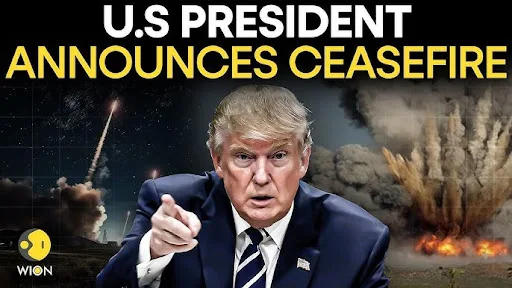Ceasefire Between Israel and Iran:-
In a dramatic turn of events, Israel and Iran have agreed to a ceasefire, bringing an end to twelve days of intense conflict that captured the world’s attention. This agreement, announced by U.S. President Donald Trump, marks a significant moment for peace in the Middle East—a region long troubled by tension and war12.
What Happened?
The conflict began with a series of missile strikes and air raids exchanged between Israel and Iran, escalating quickly and drawing in international concern. The fighting intensified after the United States launched strikes on Iranian nuclear facilities, prompting Iran to retaliate with missile barrages targeting Israeli cities like Haifa and Tel Aviv3. The violence resulted in several casualties, with at least three people killed in Israel during the final waves of Iranian missile attacks45.
How Was the Ceasefire Reached?
President Trump played a central role in brokering the ceasefire. According to his statement, both Israel and Iran approached him seeking peace almost simultaneously. Trump announced that the ceasefire would be phased in over 24 hours: Iran would begin with a 12-hour ceasefire, followed by Israel, with both sides stopping hostilities entirely at the end of the period12.
"CONGRATULATIONS TO EVERYONE! It has been fully agreed by and between Israel and Iran that there will be a Complete and Total CEASEFIRE (in approximately 6 hours from now, when Israel and Iran have wound down and completed their in progress, final missions!), for 12 hours, at which point the War will be considered, ENDED!" – President Trump2
Is the Ceasefire Holding?
The situation remains tense. While the United States announced the agreement, Iran’s foreign minister initially denied that a formal deal was reached, though he indicated Iran would halt attacks if Israel did the same65. Despite the announcement, missile attacks continued up to the ceasefire deadline, causing further casualties and uncertainty about the agreement’s durability45.
Why Does This Matter?
The ceasefire brings hope to millions affected by the conflict. For people in Israel and Iran, and for families across the region, peace means safety, stability, and a chance to rebuild. The world is watching closely, as any violation could reignite violence.
What’s Next for Israel and Iran?
Both countries have much to gain from peace—economic recovery, international support, and a safer future for their citizens.
The ceasefire is fragile; trust must be rebuilt, and both sides need to avoid provocations.
The role of international mediators, especially the United States, will remain crucial in maintaining the peace.
A Message for All Ages
Whether you are 18 or 70, the story of this ceasefire is a reminder that even the most bitter enemies can choose dialogue over destruction. It shows the power of negotiation and the importance of global cooperation. The hope is that this agreement will not just end a war, but start a new era of understanding in the Middle East.
Let’s all hope that this ceasefire is the first step toward a lasting peace—because the future of both nations, and the world, depends on it.
Conclusion:-
The ceasefire between Israel and Iran marks a hopeful turning point in a region long troubled by conflict and uncertainty. While the agreement is still fragile and challenges remain, this step shows that even the deepest divides can be bridged through dialogue and determination. For people of all ages, this moment is a reminder that peace is always possible when leaders choose negotiation over violence. As the world watches, the hope is that this ceasefire will lead to lasting stability, safety, and a brighter future for everyone in the Middle East. Let us all remain optimistic and support efforts that bring nations together, proving that peace is not just a dream, but a real and achievable goal.







No comments:
Post a Comment